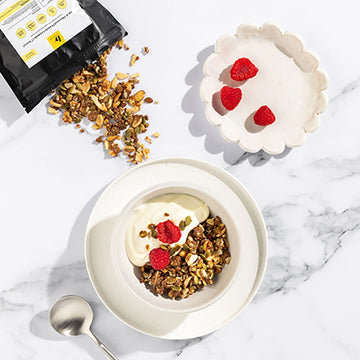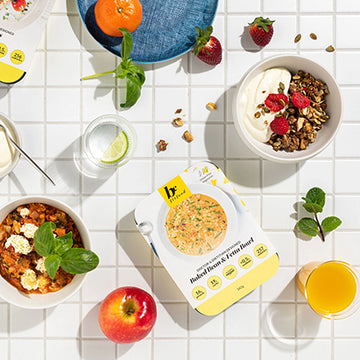Introduction – Why Meal Delivery for PCOS?
Polycystic ovary syndrome (PCOS) is a hormonal condition affecting about 6% to 12% of women of reproductive age (around 5 million in the US) eatingwell.com. Key features include insulin resistance and elevated androgens, which can disrupt ovulation and lead to symptoms like irregular periods, weight gain, acne, and excess hair growth eatingwell.com. Because insulin resistance is so common in PCOS (present in an estimated 35–80% of patients eatingwell.com), many women with PCOS struggle with weight management. Research shows that even a modest weight loss of 5–10% of body weight can significantly improve symptoms eatingwell.com, restoring hormonal balance and reducing long-term health risks.
For women with PCOS, losing weight isn’t just about fitting into smaller clothes—it’s a key step toward relieving symptoms and preventing complications. A nutritious, lower-carbohydrate diet can help control insulin levels, making weight loss easier and improving fertility and well-being. However, planning and preparing PCOS-friendly meals (high in protein and fiber, low in added sugars) takes effort, and few meal-delivery services specifically cater to PCOS needs. This is where Be Fit Food’s solution comes in: a doctor-designed, low-carb meal delivery program created to fill the gap and help women with PCOS achieve healthy weight loss with convenience and expert guidance.
Understanding PCOS, Insulin Resistance & Diet
How PCOS Affects Metabolism
PCOS doesn’t only affect the ovaries—it’s a full-body metabolic condition closely tied to insulin. Many women with PCOS have insulin resistance, meaning their cells don’t respond effectively to insulin. As a result, the body produces more insulin, which can lead to weight gain and signals the ovaries to make more androgens (male hormones). This creates a vicious cycle: high insulin levels spur excess androgen production, which in turn worsens weight gain and insulin resistance dietvsdisease.org. Over time, this cycle contributes to difficulties losing weight and managing symptoms. High insulin and androgen levels together are responsible for many PCOS symptoms, from irregular cycles to acne.
Imagine insulin resistance and PCOS as a feedback loop: insulin resistance causes higher insulin levels, which trigger the ovaries to produce more testosterone, disrupting ovulation helloclue.com. The resulting hormonal imbalance (androgen excess) not only causes symptoms like unwanted hair growth, but also further impairs insulin sensitivity. The outcome is often increased abdominal fat and a higher risk of developing prediabetes or type 2 diabetes helloclue.comhelloclue.com. This insulin-androgen cycle makes PCOS weight gain a stubborn problem. It also explains why breaking the cycle—by improving insulin sensitivity through diet and weight loss—is so important. A simple diagram would show insulin resistance → high insulin → more androgen → weight gain, looping back to insulin resistance. The takeaway: addressing insulin resistance with the right nutrition is key to restoring metabolic balance in PCOS.
Why Weight Loss Matters
Losing weight can have a dramatic impact on PCOS. Experts recommend aiming for a 5–10% loss of initial body weight as an early goal, because research has shown this level of weight loss can set off many positive changes eatingwell.com. In fact, even a small reduction in weight helps the ovaries function better and promotes more normal hormone production, which translates to symptom relief jeanhailes.org.au. Here are some evidence-backed benefits of moderate weight loss for women with PCOS jeanhailes.org.au:
● Improved insulin sensitivity: Weight loss can cut insulin resistance by ~50%, helping lower elevated insulin levels.
● Restored ovulation and regular periods: Many women find that losing a few kilograms is enough to resume more regular menstrual cycles and ovulation, improving fertility.
● Reduction in excess androgen levels: As insulin levels normalize, the ovaries produce fewer androgens – reducing symptoms like acne and hair growth.
● Better fertility and pregnancy outcomes: A 5–10% weight reduction is linked to higher pregnancy success rates and fewer complications during pregnancy jeanhailes.org.au.
● Enhanced mood and energy: Women often report higher self-esteem and reduced anxiety or depression as hormones rebalance and energy levels rise.
● Lower risk of diabetes and heart disease: Weight loss helps halve the risk of developing type 2 diabetes, and it improves cholesterol and blood pressure, protecting long-term health jeanhailes.org.au.
In short, weight loss matters because it attacks the root causes of PCOS symptoms. By shrinking excess fat (especially around the abdomen), you reduce the insulin resistance and inflammation that fuel PCOS. Losing just 5% of your weight might restore ovulation or clear up skin – it’s that powerful a toolphc.ox.ac.uk. The goal isn’t an overnight transformation, but these modest improvements can significantly enhance quality of life for women with PCOS.
Dietary Principles for PCOS Weight‑Loss
Blood‑Sugar Balancing Guidelines
Because of the link between blood sugar and PCOS, eating in a way that keeps insulin stable is crucial. This generally means emphasizing protein, fiber, and healthy fats while moderating carbohydrate intake. Here are key PCOS nutrition guidelines for balancing blood sugar eatingwell.com:
● Prioritize Protein: Aim for 25–30 grams of protein per meal (about a palm-sized portion of meat or fish, or a heaping cup of Greek yogurt/legumes). Protein keeps you full and prevents blood sugar spikes by slowing carb absorption. Include ~8–10 g protein in snacks as well (for example, a hard-boiled egg or a small handful of nuts) eatingwell.com.
● Include Healthy Fats: Don’t fear fats – healthy fats in each meal (such as olive oil, nuts, seeds, avocado, or fatty fish) actually help slow digestion and stabilize glucose levels eatingwell.com. For instance, cooking veggies in olive oil or adding chia seeds to a smoothie can blunt insulin spikes.
● Fill up on Fiber: High-fiber foods also moderate blood sugar. Aim for ~30 g of fiber per day from vegetables, fruits, legumes, and whole grains eatingwell.com. Fiber not only aids weight loss by promoting fullness, but also lowers the glycaemic impact of any carbs you eat.
● Choose Quality Carbs: You don’t have to cut out carbs entirely, but focus on whole, unrefined carbohydrates over refined ones. Opt for whole-grain options (e.g. brown rice, quinoa, oats) or starchy vegetables/legumes, and minimize added sugars and white flour products eatingwell.com. These whole carbs have more fiber and a lower glycaemic index, which means gentler effects on blood sugar.
● Portion Control: Following a balanced plate model can help. A simple guide is the MyPlate method: fill half your plate with non-starchy veggies, one-quarter with lean protein, and one-quarter with a high-fiber starch or whole grain eatingwell.com. This naturally creates the right macro balance for steady blood sugar. Also, try to eat meals and snacks at regular intervals (every 4–6 hours) to avoid both crashes and constant high insulin levels eatingwell.com.
To summarize these principles, here’s a quick reference table for macronutrient targets per meal:
| Macronutrient | Per Meal Goal | Examples of Sources |
|---|---|---|
| Protein | 25–30 g per meal (8–10 g per snack) | Lean meats, fish, eggs, tofu, Greek yogurt, legumes |
| Healthy Fats | Include in every meal (~1–2 tbsp) | Olive or avocado oil, nuts and seeds, avocado, fatty fish (salmon) |
| Carbs | Emphasize low-GI, high-fiber carbs; keep portions moderate (≈1/4 of plate) | Non-starchy veggies (broccoli, leafy greens), whole grains (quinoa, brown rice), legumes, berries |
Ensuring each meal has protein and fat, and choosing complex carbs over sugary/refined ones, will help prevent the blood-sugar rollercoaster that exacerbates PCOS. You’ll feel fuller longer and have more consistent energy – which also means fewer cravings.
Anti‑Inflammatory Eating
PCOS is often accompanied by chronic inflammation eatingwell.com, so an anti-inflammatory diet goes hand-in-hand with blood-sugar control. In practice, this means eating plenty of colorful, whole foods and cutting back on pro-inflammatory ones. Key tips include eatingwell.com:
● Pile on the Produce: Fruits and (especially) vegetables are rich in antioxidants and anti-inflammatory compounds. Aim to “eat the rainbow” – e.g., leafy greens, berries, cruciferous veggies, peppers – to get a variety of nutrients eatingwell.com. Try to fill half your plate with non-starchy veggies at meals. The vitamins and plant compounds in colorful produce can help counteract the low-grade inflammation seen in PCOS.
● Favor Omega-3 Fats: Fatty fish like salmon, sardines, and mackerel provide omega-3 fatty acids, which are highly anti-inflammatory. Include fish at least twice a week if possible eatingwell.com. Plant sources of omega-3s (like walnuts or flaxseeds) and anti-inflammatory fats like extra-virgin olive oil are great additions as well eatingwell.com. Using olive or avocado oil in cooking instead of vegetable oils can help reduce inflammatory markers.
● Add Herbs and Spices: Turmeric, ginger, garlic, cinnamon and other herbs/spices have natural anti-inflammatory effects eatingwell.com. They’re an easy way to boost flavor and health – for example, season roast veggies with turmeric and black pepper, or add ginger to your smoothie. Little diet tweaks like this can cumulatively benefit inflammation levels.
Equally important is knowing which foods to avoid or limit because they can worsen inflammation or blood-sugar control. Here are some to watch out for:
● Deep-fried and Processed Foods: Foods fried in unhealthy oils (like chips, fried chicken, french fries) and highly processed snacks often contain trans fats or oxidized oils that promote inflammation. It’s best to minimize these or save them for rare treats. Likewise, limit foods very high in saturated fats (e.g. processed red meats, sausages, butter) as excess saturated fat can heighten insulin resistance and inflammation.
● Sugary Drinks and Sweets: Be cautious with sugary sodas, sweetened coffees, fruit juice, and energy drinks – these liquid calories spike blood glucose rapidly and contribute to inflammation. Even 100% fruit juice, while more natural, delivers a concentrated sugar load without fiber. Opt for water, herbal tea, or sugar-free drinks most of the time. (Jean Hailes for Women’s Health specifically advises avoiding soft drinks, sweet juices and flavored milks if you have PCOS jeanhailes.org.au.) Similarly, limit desserts, candy, and refined carbs like white bread or pastries, as these are high-GI and inflammatory eatingwell.com.
● Excessive Alcohol: Alcohol in large amounts can affect blood sugar and add strain to the liver (which is already busy processing hormones and insulin). Moderate if needed, and stick to recommended limits (no more than 1–2 standard drinks per day, with some alcohol-free days) jeanhailes.org.au.
By focusing on whole foods and healthy fats – and cutting back on sugars and fried foods – you create an eating pattern that not only aids weight loss, but also calms the inflammation underlying PCOS. This one-two punch of low-carb + anti-inflammatory eating is exactly what many women with PCOS find helpful for feeling better.
Sample Day’s Menu & Meal‑Delivery Options
One‑Day Low‑Carb, Low‑Sugar Menu
Below is a sample of what a PCOS-friendly day of eating could look like. It’s a lower-carb, low-glycemic-load menu, inspired by dietitian-developed PCOS plans dietvsdisease.org. The day’s meals prioritize protein and fiber, keep added sugars minimal, and total around 1,200 calories – a level often used for weight-loss. Nutritionally, this example provides roughly 80+ grams of protein, under 50 grams of net carbs, and plenty of non-starchy vegetables.
| Meal | Menu Example | Calories | Macros (P/C/F) | Est. Glycemic Load |
|---|---|---|---|---|
| Breakfast | 2 scrambled eggs cooked with spinach (in olive oil) | ~200 kcal | 12g P / 2g C / 14g F | ~0 (very low) |
| Lunch | Tuna salad (mixed greens, cucumber, tomato) with olive oil & lemon dressing; plus a handful of almonds | ~350 kcal | 28g P / 7g C / 20g F | ~2 (very low) |
| Snack | Carrot and cucumber sticks with 1/4 cup hummus | ~150 kcal | 4g P / 9g C / 6g F | ~3 (low) |
| Dinner | Grilled salmon (120g) with steamed broccoli & zucchini, and 1/2 cup lentils on the side | ~450 kcal | 34g P / 20g C / 19g F | ~5 (low) |
Daily Total: ≈1150 kcal, Macros ~28% protein, 15% carbs, 57% fat, Glycemic load per meal all in the low range (under 10). Despite the higher fat percentage, the fats are predominantly healthy unsaturated fats (olive oil, salmon, nuts) and the carbs are high-fiber. This balance helps maximize insulin sensitivity.
On this menu, each meal has a source of lean protein (eggs, tuna, salmon) and plenty of veggies. Breakfast is low-carb but nutrient-dense, featuring eggs (to stabilize morning blood sugar) and spinach for fiber. Lunch provides protein and healthy fats with tuna and olive oil, and extra crunch from almonds – very filling for relatively few carbs. An optional snack of veggies and hummus offers fiber and a bit of protein; notably, snacks are kept light and low-sugar (you could also choose a piece of whole fruit or some Greek yogurt as a snack, but in PCOS weight-loss plans snacks are often minimaldietvsdisease.org). Dinner includes oily fish for omega-3s and a small portion of lentils – enough to provide B vitamins and fiber without spiking glucose. Each meal’s glycaemic load (GL) stays low, which means these foods will have a gentle effect on blood sugar and insulin levels.
Note: This sample day is just one approach – there’s flexibility in food choices as long as you hit similar macro targets. The goal is controlling carbs (especially refined ones) while enjoying plenty of protein, vegetables, and healthy fats. You can mix and match equivalent foods (for example, chicken breast instead of tuna at lunch, or cauliflower “rice” instead of lentils at dinner) to add variety.
How Be Fit Food Meets These Criteria
If planning and cooking a menu like the above sounds time-consuming, that’s exactly the problem Be Fit Food set out to solve. Be Fit Food’s meal programs are doctor and dietitian designed to align with the PCOS weight-loss guidelines we’ve discussedbefitfood.com.au. Here’s how our meal delivery meets the criteria:
● Balanced Macros & Portions: Every Be Fit Food meal is high in protein and low in carbohydrates, with controlled portion sizes (most meals are ~250–350 calories). This mirrors the PCOS recommendations of ~25+ grams protein per meal and limited carbs. By following our program, you naturally reduce overall calorie intake to support weight loss, while still feeling satisfied from the protein and veg. All recipes are crafted to promote a mild ketosis (fat-burning state) for effective fat lossbefitfood.com.au, but in a safe, guided manner.
● Emphasis on Vegetables: Our chefs sneak 4–12 different vegetables into every mealbefitfood.com.au! This means you’re getting a fantastic amount of fiber, antioxidants, and volume to keep you full. For example, a Be Fit Food beef lasagna might hide zucchini, carrot, spinach, onion and tomato within its layers. You’re essentially eating a “rainbow” of produce daily, supporting that anti-inflammatory approach without even having to grocery shop.
● Quality Ingredients, No Added Sugar: Real, whole foods are the cornerstone of Be Fit Food’s mealsbefitfood.com.au. We use lean proteins (e.g. grass-fed beef, skinless chicken, fresh fish, tofu), healthy fats, legumes, nuts and seeds – not cheap fillers or excessive sugar/salt. All our sauces and recipes are nutritionally balanced and free from added sugars and artificial junk. This keeps the total sugar and glycemic load of your daily intake very low, exactly what women with PCOS need.
● Low-Carb Convenience: Perhaps the biggest advantage is convenience without compromise. The sample menu above requires cooking and prep; in contrast, Be Fit Food delivers snap-frozen, ready meals to your door, ready to reheat. You get the same metabolic benefits of a low-carb, PCOS-friendly diet without the hassle. It’s easier to stay consistent when breakfast, lunch, and dinner are pre-portioned and waiting – no risk of accidental high-carb options. Plus, our programs come with dietitian support and a recommended extras list (like which fresh fruits or snacks you can add) so you’re never on your own.
In essence, Be Fit Food’s PCOS Weight-Loss Meal plan is a real-world execution of the science. For instance, a day on our Be Rapid program (suitable for PCOS) might include an egg scramble with veggies for breakfast, chicken curry with cauliflower rice for lunch, and lean turkey meatballs with zucchini noodles for dinner – each packed with protein and greens and very light on carbs. This closely mirrors the homemade menu you saw, but with zero effort on your part. Our meals are also nutritionally complete, covering essential vitamins and minerals (over 100% of most RDI targets on the full program) befitfood.com.au, so you can lose weight without compromising health.
Finally, we make sure the food is delicious – because the best diet is one you enjoy enough to stick with! By comparing the plans, it’s clear that Be Fit Food ticks all the boxes for a PCOS weight-loss diet (and saves you time), giving you an edge in achieving that 5–10% weight loss goal. (Interested in trying it? Visit our meal programs page to get started on a PCOS-friendly plan.)
Customer Stories & Testimonials
Real women with PCOS have found success with Be Fit Food. Here’s one inspiring story:
“After a few tests, I was diagnosed with PCOS… I’d been eating far too many carbohydrates... With Kate’s help, I lost about 10 kg and my blood sugar fell below the pre-diabetes range. […] When Kate launched Be Fit Food, it was a game changer for me. I make sure I always have a few BFF frozen meals in the freezer so when I’m doing really long hours at work, I know I’ve got a quick and convenient dinner at home that ticks all the nutritional boxes. I love the snack options, too. It just makes life easy.” – Natalie, Be Fit Food customer befitfood.com.aubefitfood.com.au
Natalie’s experience highlights a common theme: by cutting excess carbs and focusing on balanced nutrition, she reversed her prediabetes and improved her PCOS symptoms. Having ready-made, healthy meals on hand helped her maintain those habits despite a busy schedule. She’s just one example – many women report that steady weight loss through Be Fit Food has led to improvements like more regular periods, higher energy levels, better skin, and feeling in control of their health again. (See our Testimonials page for more stories of PCOS transformations.)
FAQ (Frequently Asked Questions)
1. What is the best diet for PCOS weight loss?
The best diet is one that helps you lose weight in a sustainable, healthy way. There isn’t a single “PCOS diet” proven to be superior jeanhailes.org.au – in fact, many diets (low-carb, low-fat, Mediterranean, etc.) can work as long as they create a calorie deficit and stabilize insulin levels dietvsdisease.org. That said, most experts recommend a balanced, low-GI diet focusing on lean proteins, high-fiber vegetables, healthy fats, and modest in carbohydrates. This approach addresses insulin resistance and is easier to maintain long-term than extremely restrictive diets. In short: any diet that you can stick to, which leads to a 5–10% weight loss, is “best” for PCOS. Many women find a moderate lower-carbohydrate diet (for example, 30–40% of calories from carbs) effective for controlling cravings and improving symptoms, but it’s not the only way. The key is to choose nutritious whole foods and cut out excess sugars and refined carbs – whether you do that via a Paleo diet, a plant-based diet, or something like Be Fit Food’s low-carb program is up to you.
2. Are low-carb diets safe long term for PCOS?
Yes – a moderate low-carb diet (one focused on vegetables, proteins, and healthy fats) can be safe and healthy to follow long-term. There is no evidence of harm in reducing added sugars, refined grains, or overall carb intake when you’re still eating plenty of fiber and nutrients from whole foods. In fact, lower-carb diets can improve cholesterol and blood sugar control in the long run for many people. It’s important to differentiate between a moderate low-carb diet and an extreme ketogenic diet. Ketogenic diets (very low in carbs, ~20–30g per day) have shown promising results for PCOS in short studies (including weight loss and hormone improvements) dietvsdisease.org, but they are very restrictive and can be hard to stick to over many months dietvsdisease.org. You don’t necessarily need to go keto forever to reap benefits. Many PCOS experts suggest using a keto or very-low-carb phase for a few months if needed, then transitioning to a slightly higher (but still healthy) carb intake. The bottom line: a low-carb lifestyle is generally safe long-term as long as you get enough vegetables, protein, and calories for your body’s needs. Always listen to your body and work with a healthcare provider if you have any concerns (for example, if you’re on medications like insulin or metformin, you’ll want medical guidance when changing your diet).
3. How fast can I expect results with a PCOS weight-loss plan?
It depends on the individual, but a gradual weight loss of about 0.5 to 1 kg per week (1–2 lbs/week) is a common, safe pace. Women with PCOS sometimes lose weight a bit more slowly than others (due to metabolic differences), so don’t be discouraged if progress is steady rather than lightning-fast. What’s important is the trend. Typically, within 3–6 months of consistent healthy eating and activity, many women can lose around 5–10% of their body weight – and this is enough to start seeing significant improvements in symptoms jeanhailes.org.aunhs.uk. For example, some women notice more regular periods or better skin after losing as little as 5 kg. Improvements in energy and mood can happen even sooner (within a few weeks of cutting out sugar and eating better, you may feel less fatigue and brain fog). If you’re following a structured meal plan like Be Fit Food, you might see a larger drop in the first week or two (often due to water weight shifting on a low-carb diet), then a sustained modest loss each week. Remember that PCOS is not cured overnight – it’s a journey. Setting realistic goals (such as “2 kg per month” or “8–10 kg in 6 months”) and focusing on non-scale victories (sleep, mood, cycle regularity) will help keep you motivated. And even when the scale moves slowly, you are improving your health internally. Consistency is key; if you stick with the plan, results will come.
4. Can I customize these meals for my allergies or preferences?
Absolutely. A PCOS-friendly diet is not one-size-fits-all, and it’s important that it works for you. If you’re cooking at home, you can swap proteins or veggies as needed (e.g. if you’re dairy-free, use coconut yogurt instead of Greek yogurt; if you’re vegetarian, rely on plant proteins like tofu, beans, lentils, and nuts). For Be Fit Food’s meal delivery, we offer a variety of meals and you can select options that suit your needs. All our meals are prepared in a 100% gluten-free kitchen to avoid cross-contamination, so they are safe for those with coeliac or gluten intolerance befitfood.com.au. We also clearly label meals that are dairy-free, nut-free, etc., and our dietitians can help you adjust the program if you have a specific allergy. For example, if you have a seafood allergy, we’ll ensure your menu avoids fish meals and includes other protein alternatives. The goal is for you to get the benefits of a low-carb, low-sugar diet without worrying about an allergic reaction. Just let us know your dietary requirements when ordering, and we’ll accommodate as much as possible. In general, focusing on whole foods naturally makes the plan adaptable – you’ll be eating lots of veggies, lean meats, and unprocessed ingredients, which is friendly for most common diets (gluten-free, lactose-free, etc.). Always double-check ingredient lists if you have severe allergies, but rest assured, PCOS weight-loss diets can be customized so that you stay safe, satisfied, and on track.
Expert Commentary & Evidence
Nutrition and endocrine experts agree that diet is a first-line therapy for managing PCOS – and the science behind low-sugar, low-carb diets explains why. “High insulin is not just a symptom of PCOS – it’s a major driver of the condition,” explains Dr. Lara Briden, a naturopathic doctor specializing in women’s health helloclue.com. By lowering insulin levels through diet, you can break that PCOS cycle of insulin → androgen → weight gain. Studies support this approach. For example, a 2020 clinical trial showed that reducing carbohydrates led to significantly improved insulin sensitivity and weight loss in women with PCOS when compared to a standard diet dietvsdisease.orgdietvsdisease.org. Another study reported that after 24 weeks on a very low-carbohydrate ketogenic diet, women with PCOS on average lost 12% of their body weight and saw a 54% drop in fasting insulin levels dietvsdisease.org – a remarkable metabolic improvement. These women also had lower testosterone levels and more regular cycles as a result. While keto-level carb restriction isn’t necessary for everyone, it illustrates how powerful carb reduction can be in addressing the root issues of PCOS.
Registered dietitians often emphasize that the quality of carbs matters as much as quantity. Complex carbs (like those from vegetables, legumes, low-GI fruits and whole grains) have a much gentler effect on blood sugar, and thus on insulin, than refined carbs do. That’s why both the Australian PCOS guideline and the international evidence-based guideline (2018) stress a high-fiber, low-GI diet as part of PCOS management. It’s not about fad diets, but about eating in a way that keeps your insulin and blood glucose levels steady. As nutrition scientist Nikolaos Kazantzis et al. noted in a 2021 review, “diets emphasizing low glycemic load not only facilitate weight loss but directly improve menstrual regularity and ovulation in PCOS patients” (Kazantzis 2021, Nutrients journal). This evidence aligns with what women often experience anecdotally – when they cut out sugary foods and excess starch, they see less bloating, better skin, and more balanced cycles.
Besides diet, exercise is the other cornerstone of therapy. The consensus among experts is to combine diet changes with regular physical activity for best results helloclue.com. Aim for at least 150 minutes of moderate exercise per week (for example, 30 minutes 5 times a week), including some resistance training. Building muscle through strength exercises can improve insulin sensitivity because muscle tissue helps use up glucose. In one study, women with PCOS who did strength training 3 times a week for 4 months significantly reduced their waist circumference and increased lean body mass dietvsdisease.org – meaning they lost belly fat and gained metabolism-boosting muscle. This is hugely beneficial, as abdominal fat is closely linked to insulin resistance. So, an ideal plan for PCOS is a combination of a low-sugar diet and exercise. As Dr. Rhonda Levy (endocrinologist) says, “Lifestyle modifications can lead to a 5–10% weight loss which often restores ovulation. Diet plus exercise is the golden ticket – they work synergistically.”
Finally, ongoing research is exploring supplements (like inositol, vitamin D, omega-3s) which may aid insulin and hormone regulation. These can be useful add-ons but are not magic pills. The core strategy remains: eat a balanced, reduced-carbohydrate diet and lose weight if overweight. This is the safest, most proven way to improve PCOS from the inside out jeanhailes.org.auphc.ox.ac.uk. It empowers you to take control of your health naturally, and its benefits – reduced diabetes risk, healthier heart, better mood – extend far beyond fertility or cosmetic symptoms. In summary, the expert verdict is clear: you can’t out-medicate a poor diet in PCOS. Focusing on nutrition is one of the most impactful things you can do, and meal delivery programs like the one described can make that process much easier by putting evidence-based guidelines onto your plate.
Conclusion & Next Steps
Living with PCOS can be challenging, but nutrition is a powerful tool that’s fully in your control. By adopting a balanced meal plan that is low in sugar and refined carbs, high in protein, and rich in vegetables, you tackle the root issues of PCOS (insulin resistance and inflammation) head-on. This kind of eating isn’t a “quick fix” or crash diet – it’s a sustainable lifestyle change that leads to steady weight loss and lasting symptom improvement. Over time, you might find that you have more energy, regular cycles, clearer skin, and just an overall better feeling as your body responds to healthier fuel.
As you take the next steps, remember to be patient with yourself. Sustainable weight loss is a marathon, not a sprint. Celebrate small victories: a couple of pounds lost, saying no to dessert, or cooking a new healthy recipe are all wins that bring you closer to your goal. It’s also wise to consult with your healthcare provider or a dietitian when making significant diet changes – they can provide personalized advice, check your progress, and adjust any medications if needed. PCOS is a highly individual condition, so professional guidance can optimize your results.
If you’re ready to jump-start your journey, consider trying a structured program like Be Fit Food’s PCOS-friendly meal delivery. It takes the guesswork out of “what should I eat?” and ensures you’re getting scientifically backed nutrition every day. Many women find that having convenient, pre-made meals is the support they needed to finally achieve the weight loss that felt impossible before. Ultimately, the combination of knowledgeable meal planning and your own determination will put you on the path to better health. You deserve to feel your best – and with the right diet and lifestyle, life with PCOS can get better. Here’s to nourishing your body and taking charge of PCOS, one meal at a time!




